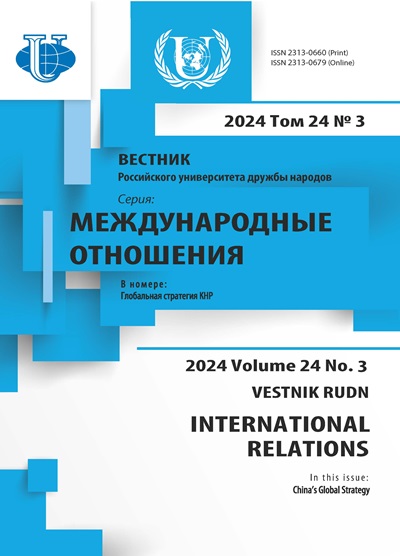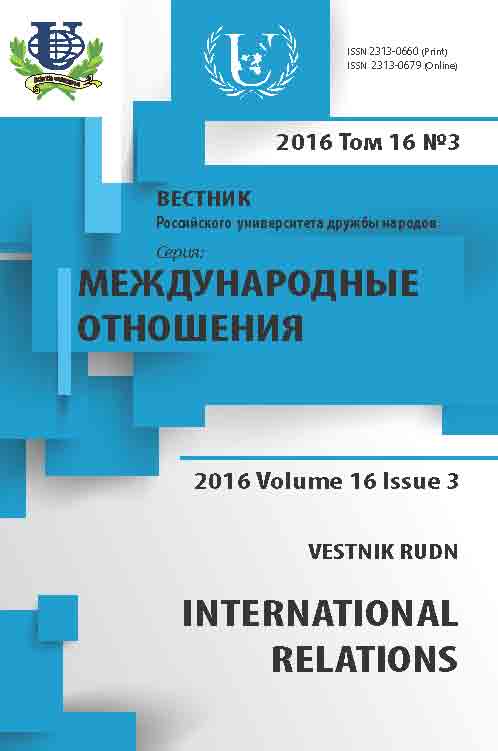Geopolitical Dimensions of the Syrian Conflict
- Authors: Wakim J.1, Kuznetsov A.A.2
-
Affiliations:
- Beyruth Arab University
- The Russian Presidential Academy of National Economy and Public Administration
- Issue: Vol 16, No 3 (2016): International Conflicts: Quo Vadis?
- Pages: 461-472
- Section: Articles
- URL: https://journals.rudn.ru/international-relations/article/view/14764
Cite item
Full Text
Abstract
This article touches upon geopolitical dimension of the Syrian conflict. The authors consider in details regional subdivision of Syria and relations of Syrian regions with border countries. The authors of the article conclude that Arab nationalism as the Syrian state ideology and positioning of Syria as the center of Arab world were indispensable taking into account multiconfessional nature of Syria. Authors study the geostrategical doctrine of Hafez Asad (1970-2000) aimed to restore the territorial integrity of Syria (return of the Golan heights) and creation of Great Syria, bring to light reasons of the alliances of Syria with Soviet Union and Iran. The authors discover reasons of hostility toward Syria from such actors as United States, Saudi Arabia, Turkey. The hostile attitude of the US political elites toward the Syrian state can be explained by American intention to undermine strategic partnership between Syria and Iran. Enmity of Saudi hostility toward the Syrian regime began with the assassination of the Lebanese Prime Minister Rafic Hariri (2005). This action destroyed the political balance in Lebanon and was considered by the Saudis as a threat to their interests. Article contains analysis of the Syrian role in the Saudi-Iranian rivalry. To opinion of the authors, Turkish involvement in the Syrian conflict began with the attempts of the regime’s change in this country and evolved to the defense of Turkish national interests from the Kurdish factor. The authors make some conclusions about the role of US, Iran, Saudi Arabia, Turkey in the Syrian conflicts. In the article it’s made some forecasts about the development of Syrian conflict. The authors especially predict possibility of disintegration of the Syrian state according to spheres of influence of the external actors involved to this conflict with Mediterranean coast, Homs and Damascus under the control of government, northern regions of the country under Kurdish control, Raqqa and Deir el Zor probably under Turkish control and the Southern Syria (Hawran) probably under Jordanian control.
Keywords
About the authors
Jamal Wakim
Beyruth Arab University
Author for correspondence.
Email: jamalwakim1@gmail.com
Beyruth, Lebanon
Alexander Andreevich Kuznetsov
The Russian Presidential Academy of National Economy and Public Administration
Email: samarkand4@yandex.ru
Moscow, Russia
References
- Аleksandrov, А.I. (2013). Syria: o voennom I diplomaticheskom kontekste podgotovki k conferencii Geneva-2 [Syria: a military and diplomatic preparation for the conference "Geneva-2"]. URL: http://www.iimes.ru/?p=19050 (accessed:16.04.2016).
- Аhmedov, V., Кulagina, L. (2014). Syria I Iran v novoy regionalnoy obstanovke na Blizhnem Vostoke [Syria and Iran in a new regional situation in the Middle East]. URL: http://www.iimes.ru/?p=20454 (accessed: 16.04.2016).
- Bzhezinsky, Z. (2010). Velikaya Shahmatnaya doska. Amerikanskoe prevoshodstvo I ego geostrategicheskie imperativy [The Grand Chessboard. American supremacy and its Geostrategic Imperatives]. Moscow: Mezhdunarodniye otnosheniya.
- Batatu, H. (1997). Syrian Peasantry. The Descendants of its lesser rural Notables and their politics. New Jersey: Princeton University Press.
- Bekdil, В. (2016). Turkey’s fake war on jihadis. URL: http://www.meforum.org/5982/turkey-fake-war-on-jihadis (accessed: 28.02.2016).
- Davutoglu, A. (2010). Al-Umq al-Istratiji. Doha: Al-Dar al-Arabiya li al-Ulum al-Nashirun.
- Friedman, G. (2011). Syria, Iran and the Balance of Power in the Middle East. STRATFOR review.
- Goldberg J. The Obama doctrine. URL: http://www.theatlantic.com/magazine/archive/2016/04/the-obama-doctrine/471525/#7 (accessed: 28.07.2016).
- Habib, М. (2011). Tadhulu Turkiya ila azm al-Suri./ Аl Safir.
- Hourani, A. (1991). A history of the Arab peoples. Cambridge, Mass.: Belknap Press of Harvard University Press.
- Naba, R. (2008). Le parti Baas. Monstres sacrees ou sacrees monsters? Entre le Saladin babylonien et le Bismarck syrien, une détestation inexpiable. URL: http://www.renenaba.com/le-parti-baas/ (accessed: 28.06.2016).
- Nouzille, V. (2010). Dans le Secret des Presidents. Paris: Fayard.
- Seale, P. (1987). The struggle for Syria. A Study of post-war Arab politics. London: Tauris.
- Seale, P. (1997). Asad. The struggle for the Middle East. Los Angeles: University of California Press.
- Tibi, B. (1981). Arab Nationalism. A critical Enquiry. London: Mac Millan.
- Volovich, А.А. (2011). Тurciya i arabskie revolucii [Turkey and the Arab revolutions]. URL: http://www.iimes.ru/?p=12684 (accessed:16.04.2016).
- Zeine, Z. (1960). The struggle for Arab independence. Beiruth: Khayat.











